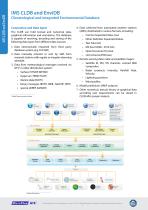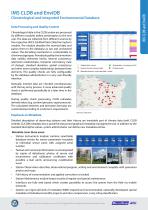
Catalog excerpts

Climatological and integrated Environmental Database FEATURES: High Availability Universal & Reliable Manual or Automatic Data Sources Climate Database Highly Configurable Quality Control Management System Metadata Management Variety of Extension Modules Available Export to Standard Formats Mathematical / Statistical Packages Advanced Graphical Presentation Tool and Map Analysis Climatological database is a critical component of any modern meteorological institute of today. The main utilization of such system is storage of all collected meteorological data in one unified structure to avoid data inconsistencies and discrepancies and to enable standard comfortable data access for all users and other software systems. Within the Climatological database (CLDB), the above-mentioned unified structure is based on SQL Database Server and the standard data access is based on SQL language. The guarantee of data storage quality is the industry-proven Oracle® Database Server, the world leader in database technologies. Great alternative for smaller systems is based on an open source solution offered by PosgreSQL. customization. The end user can specify additional non-standard input and output modules. Modules can be easily implemented and added to any existing or future installation. One of the most interesting extensions offered is upgrade to environmental database (integration of AWS, radar, satellite, profiler, historical observations, marine data, radiation and air pollution monitoring and more). To provide high availability of the database we use Oracle Real Application Cluster - the database solution provides fault tolerance and high performance for mission-critical applications. CLDB is based on WMO1 recommended practices for climatological data processing (WMO Guide No. 100). It follows the WMO suggestion of a RDBMS (Relational Database Management System) application with wide use in climatology (World Climate Program efforts concerning new Climate Data Management Systems - CDMSs). Great advantage of CLDB is its modular architecture, which gives the end user the possibility of detailed 1 World Meteorological Organization Customized CLDB Menu MicroStep-MIS, www.microstep-mis.com © 2016, All specifications are subject to change without prior notice. 1
Open the catalog to page 1
Climatological and integrated Environmental Database Connection and Data Input 4. Data collected from automated weather stations (AWS); distributed in various formats, including: • Comma Separated Value (csv) • Other Delimiter Separated Values • Text Files (txt) • MS Excel 2000 - 2016 (xls) • Open Document Format • xml (schema/DTD/raw) 5. Remote sensing data: radar and satellite images: • Satellite IR, WV, VIS channels, colored RGB composites • Radar products: Intensity, Rainfall Rate, Velocity • Lightning positions • Wind profiles 6. Model predictions (NWP outputs) 7. Other numerical,...
Open the catalog to page 2
Climatological and integrated Environmental Database Data Processing and Quality Control Climatological data in the CLDB system are processed by different modules before presentation to the end user. The data are collected from different sources by the respective UDCS (Unified Data Collection System) module. The module decodes the received data and passes them to the database as raw and unchecked values. The decoding mechanism is customizable to client message types. Periodical quality check monitors data validity (elements limits), internal consistency (elements relationships), temporal...
Open the catalog to page 3
Climatological and integrated Environmental Database Reports and Statistics The data stored in the database can be viewed and exported in many ways. 1. MicroStep-MIS selection tools End user applications are provided by MicroStepMIS for retrieving data from the database. Maximally flexible export from CLDB to user-defined tables is possible with user-friendly CLDB “Select” tool. When selecting the data, user can set element(s), variable(s), region(s), station(s), observation terms or time periods as a retrieval criteria. User then selects the form of output - all raw data, aggregated data...
Open the catalog to page 4
Climatological and integrated Environmental Database Map Analysis Map Analysis is a flexible computer graphics system designed for professional usage, which provides spatial visualization of climatological information and helps users by creation of more comprehensive views of historical and currently received data: • map analysis of current data, historical data and normals • comparison analysis of actual data and normal (selectable normal) • comparison analysis of actual data and historical data (selectable any historical period) • comparison analysis of selected historical data with...
Open the catalog to page 5
Aditional tools Climatological and integrated Environmental Database Radar and Satellite Data Application This application enables to display, manage, integrate into composites and archive radar data from various sites and manufacturers as well as satellite data. MicroStep-MIS, www.microstep-mis.com © 2016, All specifications are subject to change without prior notice. 6
Open the catalog to page 6
Aditional tools Climatological and integrated Environmental Database Numerical Weather Prediction Products Application The application serves for displaying, managing and archiving of Numerical Weather Prediction products. Map server enables publication of the spatial data using open standards and the implementation of the Web Map Service. The maps could be created in variety of formats. Connection to the traditional GIS architecture • Station data layer such as ESRI ArcGIS . Meteo data layer-spatial climatic analyzes • Topographic/geographic data . "Movie" mode MicroStep-MIS,...
Open the catalog to page 7
Climatological and integrated Environmental Database Multi-platform product Presentation Tier: The server and client can run on: • Microsoft Windows ® • Linux ® Web interface: jQuery, Mozilla, Chrome, Internet Explorer Mobile applications: Android, iOS Industry proven technologies: Documentation CLDB comes with extensive user’s and administrator’s documentation. User’s guide contains examples and how-to instructions. Administrator’s guide is especially focused on installation, database model, quality control settings and electronic data import. Additional guidance is covered by YouTube...
Open the catalog to page 8All MICROSTEP-MIS catalogs and technical brochures
-
MMR-116
3 Pages
-
Ultrasonic Anemometer 3D
2 Pages
-
Ultrasonic Anemometer 2D
3 Pages
-
RT1
1 Pages
-
IMS4 ATIS / VOLMET
4 Pages
-
RHT175
2 Pages
-
IMS4 MetReporter
4 Pages
-
IMS4 RVR
2 Pages
-
IMS4 ARWIS
4 Pages
-
MM10
2 Pages
-
IMS4 AWOS
6 Pages
-
IMS4 Model Suite
6 Pages
-
IMS LITE
2 Pages
-
IMS Observer Workstation
2 Pages
-
SWS-200
2 Pages
-
SWS-100 Visibility Sensor
2 Pages
-
Active Road Sensor ARS31
1 Pages
-
IRS31 Pro
1 Pages
-
IMS4 LLWAS
4 Pages
-
IMS4 AWDSS
4 Pages
-
IMS4 ARWIS 2014
4 Pages
-
IMS4 ATIS / VOLMET 2015
4 Pages
-
MWD-30A
1 Pages
-
IMS4 AMS 111 II
4 Pages
-
SAWS 111
2 Pages
-
RHT75
1 Pages
-
PT100D
1 Pages



































